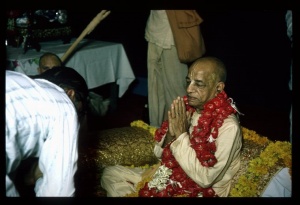CC Madhya 16.217 (1975): Difference between revisions
(Vanibot #0027: CCMirror - Mirror CC's 1996 edition to form a basis for 1975) |
(Vanibot #0020: VersionCompareLinker - added a link to the Version Compare feature) |
||
| Line 2: | Line 2: | ||
<div style="float:left">'''[[Sri Caitanya-caritamrta (1975)|Śrī Caitanya-caritāmṛta (1975)]] - [[CC Madhya (1975)|Madhya-līlā]] - [[CC Madhya 16 (1975)|Chapter 16: The Lord's Attempt to Go to Vṛndāvana]]'''</div> | <div style="float:left">'''[[Sri Caitanya-caritamrta (1975)|Śrī Caitanya-caritāmṛta (1975)]] - [[CC Madhya (1975)|Madhya-līlā]] - [[CC Madhya 16 (1975)|Chapter 16: The Lord's Attempt to Go to Vṛndāvana]]'''</div> | ||
<div style="float:right">[[File:Go-previous.png|link=CC Madhya 16.216 (1975)|Madhya-līlā 16.216]] '''[[CC Madhya 16.216 (1975)|Madhya-līlā 16.216]] - [[CC Madhya 16.218 (1975)|Madhya-līlā 16.218]]''' [[File:Go-next.png|link=CC Madhya 16.218 (1975)|Madhya-līlā 16.218]]</div> | <div style="float:right">[[File:Go-previous.png|link=CC Madhya 16.216 (1975)|Madhya-līlā 16.216]] '''[[CC Madhya 16.216 (1975)|Madhya-līlā 16.216]] - [[CC Madhya 16.218 (1975)|Madhya-līlā 16.218]]''' [[File:Go-next.png|link=CC Madhya 16.218 (1975)|Madhya-līlā 16.218]]</div> | ||
{{CompareVersions|CC|Madhya 16.217|CC 1975|CC 1996}} | |||
{{RandomImage}} | {{RandomImage}} | ||
==== TEXT 217 ==== | ==== TEXT 217 ==== | ||
<div class="verse"> | <div class="verse"> | ||
: | :'hiraṇya', 'govardhana',--dui sahodara | ||
:saptagrāme bāra-lakṣa mudrāra īśvara | :saptagrāme bāra-lakṣa mudrāra īśvara | ||
</div> | </div> | ||
| Line 25: | Line 24: | ||
<div class="translation"> | <div class="translation"> | ||
Two brothers named Hiraṇya and Govardhana, who were residents of Saptagrāma, had an | Two brothers named Hiraṇya and Govardhana, who were residents of Saptagrāma, had an income of 1,200,000 rupees. | ||
</div> | </div> | ||
| Line 32: | Line 31: | ||
<div class="purport"> | <div class="purport"> | ||
Hiraṇya and Govardhana were inhabitants of Saptagrāma in the district of | Hiraṇya and Govardhana were inhabitants of Saptagrāma in the district of Hugalī. Actually they were inhabitants not of Saptagrāma, but a nearby village named Kṛṣṇapura. They took their birth in a big kāyastha family, and although their family title has not been ascertained, it is known that they came from an aristocratic family. The elder brother's name was Hiraṇya Majumadāra, and the younger brother's name was Govardhana Majumadāra. Śrī Raghunātha dāsa was the son of Govardhana Majumadāra. Their family priest was Balarāma Ācārya, who was a favorite of Haridāsa Ṭhākura's, and the family's spiritual master was Yadunandana Ācārya, a favorite of Vāsudeva Datta's. | ||
The village of Saptagrāma is located on the | The village of Saptagrāma is located on the eastern railway from Calcutta to Burdwan, and presently the railway station is called Triśabighā. In those days there was a large river there known as the Sarasvatī, and present-day Triśabighā is a great port. In 1592, the Pāṭhānas invaded, and due to a flooding of the Sarasvatī River in the year 1632, this great port was partially destroyed. It is said that in the Seventeenth and Eighteenth Centuries, Portuguese businessmen used to come aboard their ships. In those days, Saptagrāma, situated on the southern side of Bengal, was very rich and popular. The merchants, who were the principal residents, were called Saptagrāma suvarṇa-vaṇik. There were very many rich people there, and Hiraṇya Majumadāra and Govardhana Majumadāra belonged to the kāyastha community. They also were very rich, so much so that it is mentioned in this verse that their annual income as landlords amounted to 1,200,000 rupees. In this connection, one may refer to Ādi-līlā (Chapter Eleven, verse 41), which describes Uddhāraṇa Datta, who also belonged to the Saptagrāmī suvarṇa-vaṇik community. | ||
</div> | </div> | ||
Latest revision as of 09:54, 27 January 2020

A.C. Bhaktivedanta Swami Prabhupada
TEXT 217
- 'hiraṇya', 'govardhana',--dui sahodara
- saptagrāme bāra-lakṣa mudrāra īśvara
SYNONYMS
hiraṇya—Hiraṇya; govardhana—Govardhana; dui sahodara—two brothers; saptagrāme—in the village named Saptagrāma; bāra-lakṣa—1,200,000; mudrāra—of coins; īśvara—the masters.
TRANSLATION
Two brothers named Hiraṇya and Govardhana, who were residents of Saptagrāma, had an income of 1,200,000 rupees.
PURPORT
Hiraṇya and Govardhana were inhabitants of Saptagrāma in the district of Hugalī. Actually they were inhabitants not of Saptagrāma, but a nearby village named Kṛṣṇapura. They took their birth in a big kāyastha family, and although their family title has not been ascertained, it is known that they came from an aristocratic family. The elder brother's name was Hiraṇya Majumadāra, and the younger brother's name was Govardhana Majumadāra. Śrī Raghunātha dāsa was the son of Govardhana Majumadāra. Their family priest was Balarāma Ācārya, who was a favorite of Haridāsa Ṭhākura's, and the family's spiritual master was Yadunandana Ācārya, a favorite of Vāsudeva Datta's.
The village of Saptagrāma is located on the eastern railway from Calcutta to Burdwan, and presently the railway station is called Triśabighā. In those days there was a large river there known as the Sarasvatī, and present-day Triśabighā is a great port. In 1592, the Pāṭhānas invaded, and due to a flooding of the Sarasvatī River in the year 1632, this great port was partially destroyed. It is said that in the Seventeenth and Eighteenth Centuries, Portuguese businessmen used to come aboard their ships. In those days, Saptagrāma, situated on the southern side of Bengal, was very rich and popular. The merchants, who were the principal residents, were called Saptagrāma suvarṇa-vaṇik. There were very many rich people there, and Hiraṇya Majumadāra and Govardhana Majumadāra belonged to the kāyastha community. They also were very rich, so much so that it is mentioned in this verse that their annual income as landlords amounted to 1,200,000 rupees. In this connection, one may refer to Ādi-līlā (Chapter Eleven, verse 41), which describes Uddhāraṇa Datta, who also belonged to the Saptagrāmī suvarṇa-vaṇik community.